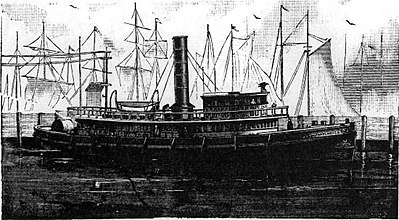William Frederick Havemeyer (fireboat)
The William Frederick Havemeyer was New York City's first fireboat.[1][2] She was commissioned in 1875, and retired in 1901. She was named in honor of a recent mayor, William Frederick Havemeyer.
Design and commissioning
The vessel was ordered in 1874, around the time Havemeyer died.[1] She was a wooden hulled steam powered vessel. She was 106 ft (32.31 m) long, 22 ft (6.71 m), had a draft of 10 ft (3.05 m), and her pumps could throw 6,000 gallons per minute. She was staffed by a crew of ten, and had accommodation for her crew to live on-board. She cost $23,800.
Operational life
In Autumn of 1880 the vessel fought a fire in Long Island City, then a separate municipality.[3]
Confrontation at the sanitation docks
On May 18, 1895, the New York Times reported on a confrontation between the Havemeyer and the Restless, a tugboat chartered to the city's sanitation department.[4] A fire had broken out at the sanitation department's "dumping wharf". The wharf, a large wooden wharf near 46th Street was used to load barges with the city's garbage. Tugboats, like the Restless, would then tow the barges out to sea, where it was dumped.
A colony of homeless men the New York Times called "wharf rats", lived in spaces within the wharf, where they supported themselves by salvaging bottles, rags, and other refuse that had resale value.[4] The New York Times blamed the fire on cooking fires the homeless men used to cook their breakfasts.
When the Havemeyer arrived at the wharf it found that the Restless was already fighting the fire with its less powerful pumps.[4] When the Restless refused to get out of the way the Havemeyer turned its pumps on it. The New York Times reported that the smaller vessel was at risk of being swamped. The conflict between the two vessels consumed fifteen minutes, only ending when a senior fire department official convinced a senior sanitation department official to order the Restless to get out of the way.
The fire was eventually extinguished when the The New Yorker came to assist the Havemeyer.[4]
References
- ↑ 1.0 1.1 Clarence E. Meek (July 1954). Fireboats Through The Years. Retrieved on 2015-06-28. “In August of 1874, the Commissioners contracted with Wood Dialogue & Company, Philadelphia, for the construction of a fireboat at contract price of $23,800. When placed in service on May 12, 1875, the boat, which had been named the WILLIAM F. HAVEMEYER, was berthed at the foot of Pike Street. East River, and Engine Company 43 was organized to man her, with two officers, two engineers, pilot and five firemen.”
- ↑ James H. Ford, 99, Civil War Veteran: Drummer Boy in '61, Captain of City's First Fireboat, Dies —Once a Texas Ranger, New York Times, 1944-07-24, p. 15. Retrieved on 2017-11-09.
- ↑ Augustine Costello. Our Firemen, The History of the NY Fire Departments, 1887, pp. 858-859. Retrieved on 2017-11-09. “April 28th the Havemeyer was reported finished, and she was manned as follows: Foreman, Thomas H. Griffiths; Assistant Foreman, James H. Ford; Engineer, Charles B. Seaver; Assistant Engineer, Patrick Hughes; Pilot, Peter Van Orden; fireman, A. H. Wright, Matthew D. Conry, James Buckley, John Stapleton, and Dennis J. Leary. She was berthed at Pier No. 1, King, succeeded Mr. Van Cott as Commissioner.”
- ↑ 4.0 4.1 4.2 4.3 Firemen Drive Away a Street-Cleaning Department Tugboat. MEANWHILE A WHARF BURNS BRISKLY A Damping-Place Damaged to the Extent of $5,000 — The Tugboat Held Out Until Threatened by the Havemeyer., New York Times, 1895-05-18, p. 9. Retrieved on 2017-11-09. “There was a sort of an opera bouffe battle early yesterday morning between a contingent of the Fire Department and the saucy crew of a tugboat at the dumping wharf of the Street-Cleaning Department, at the foot of East Forty-sixth Street.”
